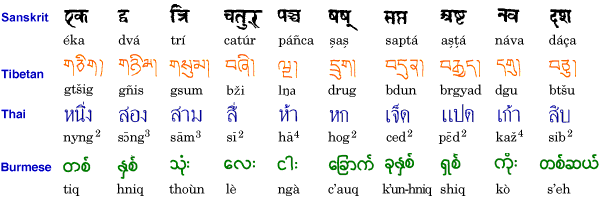

Note that these are the names of the numbers, exactly as they are represented in the numbers list (like "one, two, three"), and not symbols for numbers (like 1, 2, 3). In some cases, like Japanese, it would be rather strange to write out the numbers this way-- the Japanese would use the Chinese or Western symbols, instead.
The samples are arranged by type of writing system, rather than by language family, as in the main list. Field notes are provided for recognizing each type in the wild.

Chinese characters each represent a single syllable, and in the vast majority of cases a single morpheme. They don't represent ideas directly. Most characters can be decomposed into two simpler characters, a radical vaguely indicating the meaning plus a phonetic giving the approximate pronunciation.
The Sumerian, Maya, and Ancient Egyptian systems worked about the same way. The system begins, conceptually and presumably chronologically, with pictograms; but these form only a small fraction of the system. The transition to a full writing system occurs when it occurs to someone that the pictures can be borrowed to write words that sound the same but are hard to draw.
Field notes: Can be recognized by the great number of symbols, in the thousands.

The Japanese hiragana system shown here is a pure syllabary, with a separate glyph for each of the 45 possible syllables in Japanese (plus one for final -n). This wouldn't work so well in English, where there are thousands of possible syllables; but it works quite nicely in Japanese; there are not that many more syllabic signs than there are letters in English.
Most syllabaries have developed out of morphosyllabic scripts, as people realize that language can be written down just by recording the sounds. However, at least one syllabary has been invented from scratch: Sequoyah's, invented for Cherokee.
Field notes: A syllabary, unlike a morphosyllabic script, has just one symbol for each possible syllable type, rather than a set of alternatives. Depending on the language's syllable structure, the total number of glyphs will range from a few dozen to a thousand or so.

Devanagari, the Sanksrit script-- the ancestor of all the scripts shown above-- is sometimes called a syllabary, but it is more accurately described as an alphabet in which a single consonant+vowel sequence is written as a combined unit. Curiously, the unadorned glyph represents a consonant + a; the glyphs for ke, ki, ku, ko and simple k are then formed by adding a graphic variation representing the vowel to the ka glyph.
Field notes: In a modified syllabary, the different syllables that begin with one consonant all have a graphic element in common. In a true syllabary like hiragana they don't.

Consonantal scripts represent consonants but not (all) vowels. (The Aramaic numbers are shown in pointed form, that is, with little dots and squiggles that do indicate the vowels. But only the Bible and children's books are normally printed this way.)
Consonantal scripts work well for the Semitic languages, in which most roots consist of three consonants, and inflection is accomplished by changing the vowels between them; compare ka:tab 'he wrote', ka:tebu: 'they wrote', ko:te:b 'writing'. In a consonantal system all of these (barring some complications omitted for brevity) are written KTB, so that the root is always readily recognizable.
Field notes: Consonantal scripts have a small number of symbols, twenty to forty or so. The pointed form could be considered a modified syllabary.

Strictly speaking, to have an alphabet you must have glyphs for both consonants and vowels.
Fali (an African language) and Chinantec (an Amerindian one) are included to show the limits of the Roman alphabet. These languages have vowel (and consonant) distinctions the Roman alphabet doesn't provide forms for, and tones as well. Surely something better could be worked out...
Field notes: Vowels are distinct from consonants and can appear alone.

The Korean Han'gûl is a featural system, in which phonologically similar sounds are written with similar graphemes. For instance, n is written with a symbol that looks like an elongated L (you can see it in the words for 1 and 4). The related stop t is written by writing a line on top of the symbol for n; the resulting symbol, which looks like a squared-off C, can be seen at the beginning of 2 or 5.
The letters are grouped into syllables, which makes Korean text look as if it works like Chinese; but this is merely a graphic convention. Compare the words for 3 and 4, and you'll see the common elements (that is, the letters e and t).
Field notes: Similar to the difference between Devanagari and a true syllabary: the glyphs for similar sounds will look similar in a featural system, different in an alphabet.

Sign can be written; see the fascinating Sign Writing website for more. The system described is basically a featural system-- like Han'gûl, except that where the Korean system has primitives representing sounds, arranged in groups representing syllables, Sign Writing has primitives representing hand and other gestures, arranged in groups representing individual signs. Any particular Sign language can be written this way, since the symbols directly represent hand and body positions, not ideas or words.
What's particularly neat about the Sign Writing system is that it's iconic in a way the writing of speech can never be: ordinary writing has to be a visual representation of sound; but Sign Writing is a visual representation of a visual medium.